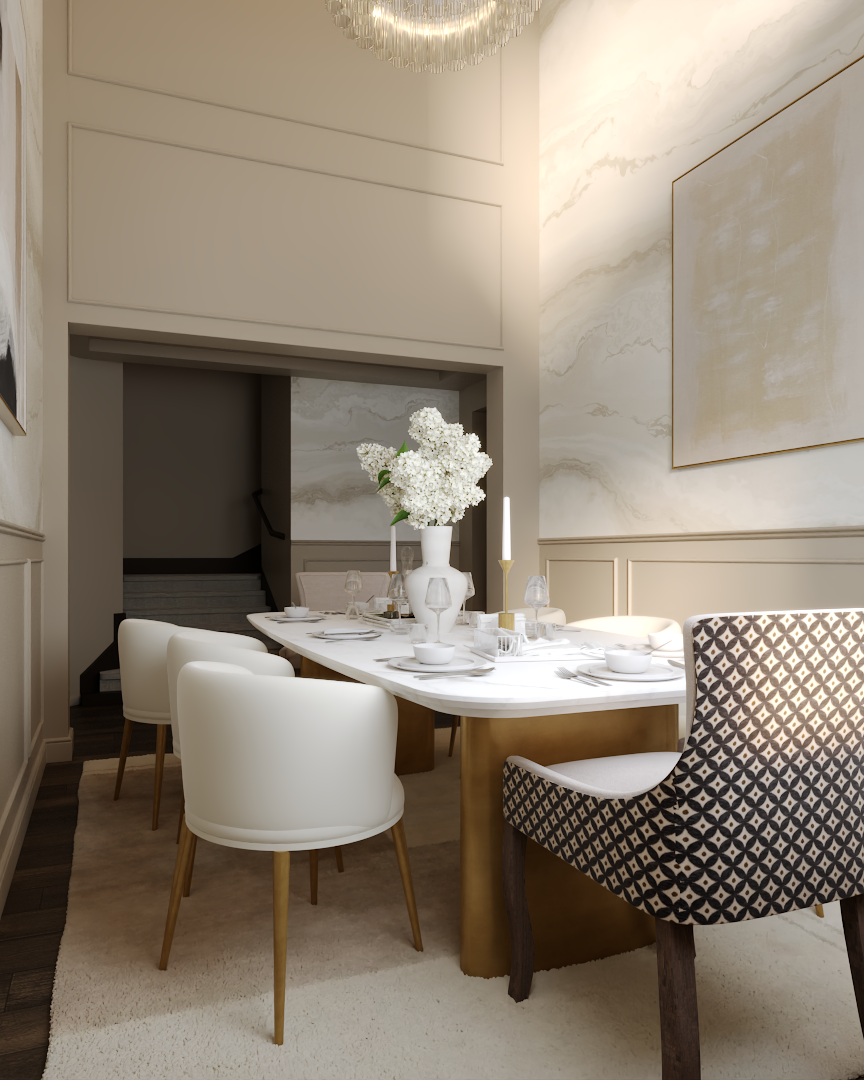The journey from an empty space to a polished neutral dining room takes careful planning and attention to detail. Below are the key elements to consider as you embark on this rewarding transformation.
1. Strategic Color Selection and Wall Finishes
Selecting the appropriate wall color is foundational. We opted for Colonnade Gray by Sherwin-Williams, admired for its ability to shift gracefully under different lighting conditions.
- Why It Works
Colonnade Gray’s balanced undertones complement both warm and cool elements in the room. This ensures your dining space feels just as inviting during a morning brunch as it does during a late-night gathering. - Try a Feature Wall
If you crave a bit more dimension, consider incorporating a neutral wallpaper dining room accent wall. Subtle geometric prints or soft metallic sheens can add depth without clashing with the overall scheme.
Pro Tip: Test paint samples at various times of day to ensure you’re comfortable with how the color changes under shifting light conditions.

The center of any dining room is, of course, the dining table. For this project, we chose the Solana Dining Table crafted from Carrara marble. Marble offers a beautiful natural pattern and a luminous quality that enhances light reflection.
“Marble is not just durable; it reflects light in a way that adds depth and sophistication to any room,” states architect Marco Bailey.
- Longevity: Marble is known for its durability, making it a worthwhile investment for families who plan to use the space often.
- Easy Coordination: Its organic veining easily pairs with neutral dining room colors, reinforcing the understated luxury of the overall design.
3. Lighting: Sculpting the Atmosphere
Proper illumination can make or break the ambiance in any room, particularly the dining area. We chose the Aurora Brass and Glass Chandelier for its soft luminosity and refined style.
“A good chandelier is like the sun of your room—it radiates and dictates the mood,” explains lighting expert Oliver Watts.
- Central Placement: Position the chandelier directly above the dining table to distribute light evenly, emphasizing the table’s centerpiece and the faces of your guests.
- Dimmer Switch: Installing a dimmer switch offers flexibility, allowing you to transition from a bright family breakfast nook to an intimate, softly-lit dinner atmosphere.
4. Textiles and Accents: Enhancing with Layers
Curtains: Framing the View
Window treatments contribute greatly to both form and function. We used the Crossweave Curtains from West Elm, which add gentle movement and softness. Their neutral, slightly textured fabric complements the walls without overpowering the serene palette.
- Height and Space: Hang curtains closer to the ceiling to give the illusion of taller windows, making the dining room feel more spacious.
- Fabric Choices: Linen blends or soft cotton in neutral shades lend a breezy, cozy feel, perfect for a comfortable dining environment.
Rugs: Grounding the Design
The right floor covering can dramatically elevate a dining space. A neutral dining room rug is an excellent option for grounding your décor and tying in all the design elements.
- Defining the Area: In open-concept homes, neutral rugs for dining room setups help delineate the dining zone from adjacent spaces like the living room or kitchen.
- Texture and Warmth: Rugs add warmth underfoot and can soften the acoustics, ensuring conversation flows without echo. Consider materials like wool or a durable synthetic blend for easy maintenance and long-term wear.
Tip: When selecting a rug for under the dining table, ensure there’s enough margin on all sides so chairs can be pulled out without catching on the rug edge.
5. Decorative Elements: The Finishing Touches
Small accent pieces can personalize the room and complete your design narrative. We added Hammond Metal Taper Holders from West Elm to introduce a metallic touch that resonates with the chandelier’s brass details. Some other subtle enhancements might include:
- Artwork
A single large canvas or a curated gallery wall can add personality. Stick to neutral or monochromatic themes to maintain cohesiveness. - Centerpieces
A vase of fresh flowers or a sculptural object on the dining table can serve as a focal point. Switch out these pieces seasonally for fresh vibes. - Table Linens
Table runners, placemats, and cloth napkins in complementary neutrals (or even a muted pop of color) can give your dining area a polished, cohesive look.
Neutral Dining Room Ideas to Suit Every Style
Neutral tones are far from one-size-fits-all; they can be adapted to a wide range of aesthetics. Here are a few creative neutral dining room ideas to spark your imagination:
- Modern Minimalist
Opt for clean lines, sleek metals, and a monochromatic palette. Strive for negative space and let the few furnishings truly shine. - Farmhouse Chic
Incorporate distressed woods, soft linens, and maybe a subtle checkered pattern. Think cream and beige with wooden beams or reclaimed wood tables for a cozy vibe. - Transitional
Blend traditional and contemporary touches. Use classic silhouettes with fresh finishes—like a vintage wooden table under a modern chandelier. - Beachy Coastal
Introduce sand-inspired neutrals, soft blues, and driftwood accents. A rattan pendant light or woven rug can give that breezy seaside feel. - Scandinavian
Emphasize light woods, lots of white, and splashes of black for contrast. Keep accessories minimal, focusing on simplicity and functionality.
The Role of a Neutral Wallpaper Dining Room
Not everyone associates wallpaper with a “neutral look,” but subtle patterns can dramatically transform a space without clashing. A neutral wallpaper dining room can feature:
- Textured Grasscloth: Perfect for adding organic warmth and depth to walls.
- Geometric Prints: Small-scale, tone-on-tone patterns create visual interest without feeling busy.
- Metallic Accents: Softly shimmering wallpapers can add a luxe dimension, reflecting light in appealing ways.
Styling Tip: If you’re hesitant about using wallpaper on all four walls, try applying it on a single accent wall to break up the expanse of paint and introduce a fresh layer of style.
Practical Considerations for a Neutral Dining Room
While design aesthetics are crucial, functionality is equally important in any dining space. Below are some practical points that often get overlooked:
- Maintenance
- Marble Sealing: If you choose a marble table, ensure it’s properly sealed to prevent stains.
- Rug Cleaning: Select rugs with stain-resistant materials. Spot-clean any spills immediately to maintain longevity.
- Lighting Adjustability
- Dimmer Switches: These are essential for transitioning from casual breakfasts to formal dinners.
- Multiple Light Sources: Consider wall sconces or table lamps for ambient lighting that complements your chandelier.
- Seating Considerations
- Chair Material: Velvet looks luxurious but can show wear over time; leather or performance fabrics may be more durable for high-traffic spaces.
- Spacing: Make sure there’s enough space between chairs and walls so guests can move comfortably.
- Future Proofing
- Modular Pieces: If you anticipate changes or expansions—like a bigger family or frequent entertaining—opt for extendable tables or modular seating.
- Timeless Palette: Sticking to neutral dining room colors makes it easier to adapt to evolving personal tastes.
Layering Design Elements for Cohesion
Layering refers to the way different elements—furniture, textiles, accessories—are arranged to create a harmonious, multi-dimensional look. In a neutral dining room, this approach is particularly potent because subtle shifts in texture, pattern, and color become more noticeable.
- Vertical Layers: Think about what occupies eye-level (art, mirrors, wall sconces), head-level (chandelier), and lower levels (table décor, chairs, rugs). Each level should feel connected yet distinct.
- Textural Layers: Combine smooth surfaces (like marble or glass) with softer textures (such as velvet chairs or woven rugs). This interplay keeps a neutral palette from feeling flat.
- Color Layers: Neutral doesn’t mean all one tone; vary your hues slightly—for instance, pair warm grays with creamy whites to introduce subtle contrast.
Common Mistakes to Avoid in a Neutral Dining Room
- Ignoring Undertones
Every paint color has an undertone—be it pink, green, yellow, or blue. Mixing conflicting undertones can create a disjointed look. - Overlooking Lighting Temperatures
Warm bulbs (around 2700K) bring out the coziness in neutral warm dining room colors, while cooler bulbs (around 3000K–4000K) might make the same colors appear stark. - Going Too Monochromatic
A room full of identical beiges can appear dull. Introduce slight variations or a pop of accent color for depth and visual interest. - Skimping on Texture
Neutrals can look flat without layered textiles—rugs, cushions, throws—or contrasting finishes. Invest in a neutral dining room rug with a subtle pattern to create visual breaks. - Inconsistent Style
Ensure all elements—from the chandelier to the table legs—tell a coherent design story.
Inspiring Neutral Dining Room Ideas for Personalized Flair
Even in a subdued color scheme, personal touches can—and should—shine through. Here are a few ideas to make your space uniquely yours:
- Gallery Wall of Personal Travel Photos
Convert your favorite vacation snapshots into black-and-white prints, which fit seamlessly into a neutral dining room while adding sentiment and personality. - Statement Wall Mirror
Mirrors reflect light, making the room feel larger and brighter. Pick a bold frame in a metallic finish that coordinates with your chandelier or other décor. - Vintage Meets Modern
Pair contemporary furniture with an antique buffet or china cabinet in a distressed finish. The blend of old and new can breathe life into neutral spaces. - Seasonal Switches
Swap out centerpieces, table runners, or decorative objects seasonally. Fresh greenery in spring, warm-hued gourds in fall—these small shifts keep your design from becoming static.
When (and How) to Introduce a Pop of Color
While the essence of a neutral dining room is calm and subdued, a strategic dose of color can become a refreshing accent. Some ways to do this without disrupting your palette:
- Upholstered Chair Cushions
Choose a subtle pastel, like a dusty blue or sage green, which pairs well with neutral hues but injects character. - Artwork or Wall Décor
A single abstract piece in vibrant hues can serve as the “hero” of the room, drawing the eye and sparking conversation. - Tabletop Accessories
From table runners to napkins, these smaller elements can be changed easily based on your mood or seasonal shifts.
The Finishing Touches: Bringing It All Together
Ultimately, a well-designed neutral dining room is about balancing serenity with subtle focal points. Every choice, from the neutral dining room rug to the chandelier, plays a role in shaping a cohesive atmosphere.
- Focus on Balance: Distribute visual weight evenly. For instance, if your dining table is a heavy, solid piece, you might opt for lighter, airy chairs.
- Quality over Quantity: Curate rather than clutter. A single quality statement piece, like a marble table, can have far more impact than multiple smaller items.
- Adapt and Evolve: Neutrals are easy to tweak. If you get bored, switch up accent pieces or lighting. You don’t have to repaint or buy all-new furniture.
Conclusion: Crafting Spaces That Bring People Together
Whether you’re hosting weekly family dinners, celebrating special occasions, or simply enjoying a quiet breakfast before work, your dining room should feel inviting, functional, and true to your personal style. As our recent project demonstrates, thoughtful design can transform an ordinary area into an extraordinary, memory making hub. By relying on neutral dining room colors, you create a timeless backdrop that adapts to evolving tastes and trends.
From the color of the walls to the choice of seating, from the subtle glow of the chandelier to the texture of a neutral dining room rug, every detail works in harmony to support a comforting, refined dining experience. By choosing neutral warm dining room colors, layering textiles, and introducing metallic or natural accents, you’ll achieve a space that feels cohesive and tranquil, perfect for conversation and culinary enjoyment.
Embark on Your Own Dining Room Transformation
You’re now armed with practical tips, expert opinions, and a host of neutral dining room ideas to spark your creativity. Whether you decide to include a neutral wallpaper dining room feature wall or opt for a statement marble table as the star of the show, remember that the goal is to design a space that reflects both your aesthetic preferences and your lifestyle needs.
Take the Next Step:
- Experiment with paint swatches or wallpaper samples.
- Research lighting fixtures that match your design vision.
- Seek out quality furniture and a neutral dining room rug that will stand the test of time.
- Layer textures and consider adding subtle pops of color for a personal twist.
With these insights in mind, you’re well on your way to creating a modern, serene dining area where every meal becomes an occasion to savor, and every gathering a moment to cherish.


